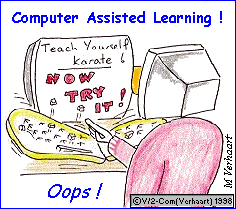Computer Assisted Learning : A Helpful Approach
in
Learning English
Nowadays,
English has become the common international language in the 21st
Century. It is the language most frequently used to communicative by people who
are not native speakers of the same language. Consequently, learning and using
English is of a great importance. Most of the new methods and theories focus on
technology applications and investigate its effect on learning. One of the
modern theories in teaching language is constructivism theory which focuses on
learning by doing and learning through technology. Technology integration is
helpful tool which can be use in the classroom to promote learners’ involvement
in learning. Moreover, technology can help learners to be responsible for their
own learning by providing an independent learning environment.
Computer Assisted Language Learning (CALL)
Computer
assisted language instruction (CALI),
and computer-aided language learning. Call is not a method, but a tool to
enable teachers to facilitate language learning process. Learners and teachers
can benefit from CALL systems, because they offer learners the chance to
practice extra learning material at their convenient time in a stress-free
environment.
Technology from the Point of View of
Constructivism
There are two major types of
constructivism, cognitive social, that can extrapolate with the use technology
in the classroom.
-
Cognitive constructivism refers
to the student-centred aspects. Students are not passive recipients of
learning; they sonstruct their own knowledge from information received.
-
Social constructivism refers to student
assistance. More advanced students help other students understand ideas or
concepts beyond their baseline level of understanding.
The one who constructs
knowledge and meaning, linking incoming or new knowledge and information to
existing knowledge.
PBL is
based on constructivist pedagogy which intends to engage learners in deep
learning process with issues and questions thatare rich and relevant to the
topic of lesson. PBL offers a specific type of learning in which learners are
expected to use technology in meaningful ways to help them investigate, learn
or present their knowledge.
Case Study
In the case institute, learners attend English
classes 6 hours a day, 5 days a week. As part of learning method in this
institute, learners are required to use a computer program within their daily
life activities which tests their English skills in different components of
language namely reading, writing, conversation, and grammar. The computer
program is a self-practice test and allows learners to finish the assignments
at their own pace and helps them to improve their skills by making them find
the correct answer before being able to proceed to the next skill.
Empirical Study
The perception edof learners on the effects of
the provided computer program on improving their English and learning that
specific component were investigated. Learners were given a questionnaire at
the end of academic semester and were supposed to measure their perception on
the effectiveness of the computer program by making it as either “not helpful”
or “completely helpful”
Overall, 106 International
learners attending the case institute took part in this study by completing the
distributed survey.
Finding and Discussion
Table show Effects of Computer Aided Learning
Group
|
English Learning
|
Component
|
|||
Reading
|
Writing
|
Conversation
|
Grammar
|
||
No. of Participants
|
106
|
56
|
63
|
34
|
16
|
Helpful
|
95
|
52
|
58
|
28
|
16
|
Not helpful
|
11
|
4
|
4
|
6
|
0
|
% Heplful
|
89.6%
|
92.9%
|
93.5%
|
82.4%
|
100%
|
% Not Helpful
|
10.4%
|
7.1%
|
6.5%
|
17.6%
|
0
|
This study proved that in
modern language learning methods derived by project based learning, computer
application will enhance the learning ability of the learners and help them
improve their English skills.



ความคิดเห็น
แสดงความคิดเห็น